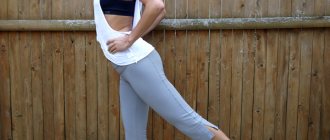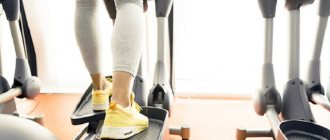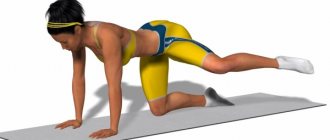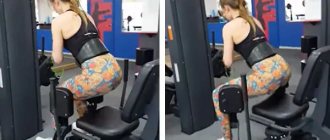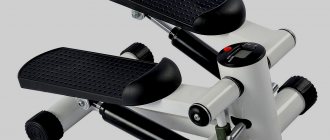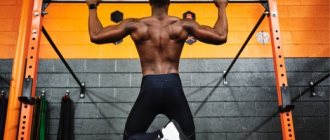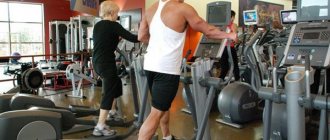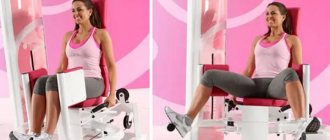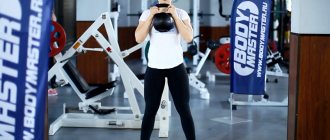In any weight loss program, the emphasis is on physical activity and proper nutrition. An excellent assistant in this difficult task is a cardio stepper, which imitates steps on the steps of a staircase. Walking up the stairs puts stress on the leg muscles, increases energy consumption, and improves blood circulation.
Walking up and down the stairs of a high-rise building is not particularly convenient, but you can “step” on a stepper right at home. A properly selected exercise program will help you lose weight, lose extra pounds on your stomach, hips, and tighten your buttocks.
What is a stepper - description and principle of operation
“Shagovik” is a simulator from the group of cardio equipment, equipped with a special pedal mechanism. Additionally, the kit may include handrails and expanders.
The simulator gives a load to the lower body (legs), allows you to work out ligaments and joints. Imitation of climbing the steps of a staircase is a good workout for the cardiovascular system, pumping up the legs and buttocks, abdominal muscles, thighs, and burning calories.
Special stepper exercises are included in rehabilitation programs for patients with musculoskeletal problems.
What is it for?
A platform with pedals is a classic, but not the only option for a stepper. Using such a simple exercise machine, the legs alternately work (“walk”), which increases endurance, improves blood circulation, and tightens muscles. It has been proven that when training on a stepper machine, the joy hormone dopamine is produced, which is responsible for the normal functioning of the heart, brain activity, and psycho-emotional background. This is an excellent prevention of despondency, depression, and bad mood.
According to reviews from those involved, the greatest effect is achieved by training of medium and low intensity. At the same time, unlike real steps on stairs, the load on the joints is minimized (the feet fit tightly to the pedals). Muscle tissues are toned, acquiring clear definition and elasticity.
In addition to the classic ones (mechanical or electromagnetic), there are balancing, rotary, and stair steppers. Balancing pedals have movable pedals, so walking becomes slightly more difficult and involves rolling from foot to foot. Coordination and sense of balance improve, additional muscle groups are loaded. Rotary models (as the name implies) are walking with body turns, and these are the kind of exercise machines that are needed to get rid of “hanging” sides.
What it pumps and what muscles it uses
The number of muscles involved when training on a cardio machine depends on its type. But, in general, when practicing on a stepper, the following “work”:
- gastrocnemius
- hip and knee extensors and flexors
- gluteal (small, medium, large0
- double-headed
- quadriceps
- feet
- medial wide
- lateral
- semitendinosus
By choosing a step machine with expanders or a balancing, rotating model, it is easy to engage the muscles of the abs, back, and arms. To begin with, eliminate (if required) excess fat by practicing minimal exercise for the maximum possible duration. Then they begin training, as a result of which a beautiful relief is formed.
Mini-exercise machines that take up little space are suitable for the home and, moreover, will not make a serious hole in the family budget. Simple “stepper” models cost from 3,500 to 5,000 rubles.
Video training on a stepper
Exercises on a home mini-stepper:
Rules for practicing on a stationary professional stepper:
Types of steppers and benefits
Steppers vary in type of movement. They are:
- Classic . A simple model that puts minimal stress on the joints and will give the desired result without much effort.
- Balancing . The center of gravity shifts, the load increases, balance develops, and coordination of movements improves.
- Rotary . Torso rotations engage the back muscles, which strengthens the entire core. The lateral abdominal muscles work actively, and a wasp waist is formed.
What is the calorie consumption for squats? Find out here!
Not everyone knows whether it is possible to lose weight by working out on a stepper. But it's possible. Moreover, you can not only lose weight, but also strengthen your muscles. You cannot build leg muscles with a stepper. But you can improve the condition of your butt . You need to walk in such a way as not to put unnecessary stress on your joints.
Those who try it know how to use a stepper. It's simple: place your feet on it and start moving slowly. Increase the pace gradually.
Even more about the beneficial properties of the stepper here: https://www.fitnessera.ru/chto-takoe-trenazher-stepper-kakie-myshcy-treniruet-i-dlya-chego-nuzhen.html
Regular training on a stepper for weight loss will help:
- tighten your butt, make your hips firmer, improve the shape of your calves;
- use the abdominal and back muscles;
- reduce weight;
- increase the level of endurance;
- improve reliefs;
- increase the effectiveness of breathing exercises.
Exercising on a stepper stimulates the production of dopamine. This hormone helps fight stress .
During the exercises you will be able to stimulate blood circulation in the lower body. And this removes cellulite. If you combine stepper exercises with proper nutrition, you will get a great shape and beauty of your body.
How to exercise on a stepper at home to lose weight
Proper training is the key to a good mood and excellent results. Therefore, before stepping on the stepper pedals, carefully study the recommendations and useful tips, be sure to precede the exercise with a light warm-up. The simulator is simple, but the effect is achieved only with a competent approach. You need to work on the step machine wisely. Start without haste, gradually increasing the load.
Be sure to monitor your heart rate using information from the simulator monitor or heart rate monitor data.
The duration of initial classes is 12-15 minutes at low intensity. The time is increased gradually, bringing it to approximately 40-60 minutes. The number of heartbeats is determined, calculating it using the formula known to many: 220 beats per minute minus age (number of years). Indicators should not exceed the specified values, go beyond the age intervals:
- for beginners – 100-110 beats per minute
- 120-135 blows – for people who are partially prepared for stress
If the heart rate is low, the effectiveness of exercise will be low; high heart rates indicate overload. Breathing, which should be calm, even, without disruptions, also indicates overload.
Before training on a stepper, warm up for 5-12 minutes to warm up and prepare the muscles.
The warm-up complex includes:
- simple physical exercises (foot rotations, leg swings, arms, 5-10 squats, bends)
- easy jogging
- rotation
- jumping rope
The same thing - after training, finish with muscle stretching (cool-down duration - 10 minutes). Warm up smoothly, without sudden movements, feeling slight tension.
For exercise, choose walking or running, be sure to reduce the pace towards the end of the workout. Basic rules for working on the simulator:
- smooth movements
- straight back
- tense abdominal muscles
- tight, complete contact of the foot with the pedal surface
- slight bending of the legs, while the knees should not extend beyond the toes of the steps on the platform
- platform boundaries
- feet stand straight, without turning inward or to the sides
- knees bend moderately, straighten moderately and never come together
All these moments are clearly controlled, otherwise the effect of the lesson will disappear. Types of load on the stepper:
- straight body - the front surface of the thigh, lumbar region are loaded
- torso slightly bent forward - load on the back of the thigh and gluteal muscles
When working on a simulator with handrails, control the load on your hands, avoiding overexertion. Towards the end of the lesson, the pace is gradually reduced and breathing is restored.
Any cardio training must be combined with proper nutrition programs. You should not start exercising immediately after eating, or consume a lot of carbohydrates. It is recommended to eat approximately 1.5-2 hours before class, and after training (30-40 minutes) to have a snack with lactic acid products and apples (can be replaced with citrus fruits).
You can't exercise on the exercise machine before bed. The optimal interval is 3-4 hours before bedtime. Be sure to alternate loads with work on other types of exercise equipment, as well as take rest during the week between classes. An approximate training regimen is 3-4 times every 8-10 days.
How to exercise correctly?
Before training you need to stretch. This is where you can learn how to properly exercise on a stepper for a slim figure.
At first, practice for 15 minutes every day. After a week, you can increase the duration of classes and intensity.
Another effective training program is “Training on an elliptical trainer”
If working without handrails, maintain a straight stance. Slight lean forward. No arching in the back. If you know how to properly exercise on a stepper to lose weight, then your body will only tense where you want it. The knees are located at a sufficient distance from each other. The feet are fully on the pedals.
Alternate between slow walking and fast steps. Start slow. Then increase the pace. After that, practice faster. And again slowly. After which everything repeats itself. When you finish doing stepper exercises for weight loss or to pump up your buttocks, slow down. In the final, you need to stretch as at the very beginning, but deeper.
Conditions for effective stepper training
Training on a stepper requires compliance with some rules:
- Do not eat 1-1.5 hours before classes;
- Do not take medications before exercise;
- You cannot exercise 2-3 hours before bedtime, otherwise sleep will be of little use;
- Breathing is deep and even. Don't hold your breath. If your inhalation and exhalation are difficult, you need to slow down the pace of exercise;
- Always warm up and cool down. Warm-up lasts 10 minutes. It will help warm up the muscles and prepare the joints for stress.
- Do not exercise indoors where there is a lot of light. Choose a room with ventilation but no drafts.
Knowing how to walk on a stepper correctly, you will benefit your body, improve your well-being, and improve your health.
It’s easy to determine your individual working speed: if, when doing exercises, your breathing is interrupted only when talking, the intensity of the load is good.
To get good results, you need to reduce the amount of carbohydrates you consume. You need to eat less protein foods. But it will also help you recover faster and improve the contours of your hips and legs. A balance in nutrition and exercise will allow you to get rid of 1 kg in 1 week.
Remember: you cannot eat 1 hour before training. If you feel hungry, eat an apple or drink a glass of kefir or low-fat cottage cheese. These products will help your muscles recover faster.
Basic rules of classes
Not everyone knows how to exercise on a stepper . But it's simple. It is important to observe the level of stress and the basic rules of training:
- You cannot move your knees inward (do not bring them together), because this may cause injury. When your feet are parallel, your knees should not reach towards each other.
- Do not put your body weight on your hands, because... The main load should be on the legs. Distribute your weight so that your lower body gets tired.
- The foot should be completely on the platform. The pressure is smooth, the legs go down, the buttocks tense. As a result, the butt gets pumped up.
- If your heels hang down, you can increase the volume of your hips by pumping up the muscles.
How to properly exercise on a stepper machine with handrails ? It is important to position your body correctly:
- lean forward slightly, focusing on your hands;
- move your butt back;
- slight arch in the lower back;
- foot on the platform, heels together, toes apart.
The main point , which will become the basis and show you how to properly exercise on a stepper, concerns the knees . The knees do not straighten completely during the stroke; they should be bent throughout the entire workout. Then the load on the lower back will be minimal. And it will be distributed over the buttocks and thighs. From the outside, such a pose looks strange. But you have to choose: either a beautiful body position during exercise, or a beautiful figure and slimness.
Take small and big steps. At first, load level 3-5 will suit you. It is also important to monitor your pulse. It must be optimal.
| Age | Pulse |
| 20-29 | 130-160 |
| 30-39 | 123-153 |
| 40-49 | 117-144 |
| 50-59 | 110-136 |
| 60-69 | 104-128 |
| from 70 | 97-120 |
Stepper exercises for slimming thighs and buttocks
Stepper exercise machines are recommended for those who want to lose extra pounds, gain a slender figure, and tighten their buttocks. How the process works:
- strengthening (pumping) muscles
- increased physical activity
- burning calories
- skin tightening
It is advisable to use various types of training, but if you work only on a step machine, then the total duration of a standard lesson should be at least 60 minutes. This time is approached gradually, without thoughtlessly increasing the load.
Approximate program (it is assumed that training on the stepper has already been carried out):
- five minutes walk at a calm pace. Arms bent at elbows
- gradual acceleration of the pace (over 4-5 minutes)
- brisk walking (1 minute)
- smooth transition to slow walking (within 3-4 minutes)
- calm step on the stepper (5 minutes)
- break (1 minute)
A new approach according to the given diagram. In total, per lesson – 3 approaches with full execution of exercises.
When walking, use your arms: work with dumbbells or expanders. Simple exercises:
- biceps curl
- rise in front of the body
- raising your arms to the sides
Standard steps are taken with a straight body, heavy steps - with the body bent forward.
In addition to losing excess weight, the stepper pumps up the gluteal muscles well. Many women dream of a seductive, elastic butt, for which they exhaust themselves with long workouts. But you need to know that the appearance of the buttocks depends on the width of the pelvic bones, on the shape of the three paired gluteal muscles, which are determined at the genetic level. Therefore, you need to train correctly, prior to pumping up your muscles with basic and aerobic exercises.
It is necessary to train the gluteus medius muscle not only for the attractiveness of the “fifth point”. Training straightens your posture, improves coordination and stabilization of the body during movement, and eliminates pain and arthrosis of the hip joint.
Sample program for the buttocks
1 Week
- warm-up 10 minutes
- one minute walk on a stepper (approximately 48-50 steps)
- rest (1 minute)
- walking (60 steps) 1 minute
- rest (1 minute)
- new approach for 2 minutes (60 steps)
- rest (1 minute)
- walk (50 steps), exactly one minute, rest.
2 week
A complete repetition of the first week's scheme.
3 week
- warm-up 10 minutes
- walk a minute (50 steps)
- rest (1 minute)
- walk two minutes (65 steps)
- rest (1 minute)
- walk 2 minutes (70 steps)
- rest (1 minute)
- walk a minute (65 steps)
- rest
- walk for a minute (65 steps).
4 week
- warm-up 10 minutes
- walk three minutes (60 steps)
- rest (1 minute)
- walk two minutes (65 steps)
- rest
- walk two minutes (70 steps)
- minute rest
- walk two minutes (70 steps)
- rest
- walk two minutes (70 steps).
The result, provided that you practice correctly and regularly and follow the approach scheme, is noticeable within 2-2.5 weeks. Starting with home exercise equipment, you can later master large steppers in the fitness room.
How to train to pump up your buttocks on an ellipsoid
Muscles begin to grow when they are stressed. To pump up your butt on an elliptical trainer, it is recommended to alternate movements at a calm pace (as when walking) with short - two to three minutes - explosive loads. In the second case, it may be an increase in resistance or a running mode.
A good effect can be obtained by performing movements as when walking backwards in a position with bent knees. Some machines allow you to use the cross-country movement mode, which is one of the most suitable for the growth of the gluteal muscles. This muscle group is also well trained by walking in a goose step - thighs parallel to the floor, keeping your back straight and vertical, arms extended forward. You can use the option of tilting your torso forward 45 degrees, but you need to keep your back straight.
Exercises for losing weight on the stomach and sides
To pump up the muscles of the upper body and shed extra pounds from the sides, they work on rotary steppers with expanders. If the model is classic, then arm exercises with weights or dumbbells are added to the basic walking programs.
Approximate training program with expanders (based on basic stepper exercises):
- walking with arms pulled back
- stretching arms forward and back
- “scissors” (swings in front of the body)
- raising elbows with bent arms)
Start with simple exercises, gradually increasing the complexity and number of approaches. Exercises are performed 18-20 times, the number of approaches is 2-3. The load is controlled by gradually increasing and applying increased effort when performing exercises. The result is a toned figure, “disappearance” of the tummy, and a beautiful silhouette.
Types of steppers, their features and how they work
As mentioned above, the simulator has several varieties. Let's look at them in detail.
Steppers are divided into types according to the design of the simulator:
- elliptical
- balancing
- classical
- turning
- hydraulic
- mini stepper
Elliptical stepper
This exercise machine has the shape of an ellipse with movable handles, handrails or expanders. This design allows you to use not only the muscles of the lower body, but also the muscles of the arms. The elliptical stepper is universal and suitable for people of any age. The minimal load it places on the joints allows the exercise machine to be used during periods of rehabilitation after injuries.
Elliptical stepper
Balancing stepper
The peculiarity of training on this stepper is the need to balance on the machine due to a shift in the center of gravity (photo). This design, in addition to the leg muscles, includes the abdominal muscles. Due to the fact that when performing the exercise it is necessary to maintain balance, the balancing stepper pumps up coordination and works the deep stabilizer muscles.
Balancing
Rotary stepper
The rotary stepper has a handle that helps you make turns on the machine, training your abdominal and back muscles.
Turning
Hydraulic stepper
Thanks to the hydraulic step load system, the simulator allows you to perform exercises at the highest level of difficulty.
Hydraulic
Classic mini stepper
If you buy a mini stepper for home, it will be an ideal home exercise machine for beginners. This stepper may come with hand expanders.
Mini stepper
We looked at the main types of steppers; they are also divided into mechanical and electromagnetic, with dependent and independent pedal travel.
Common mistakes when exercising on a stepper machine
Many people think that “stepping” on a stepper is easy and simple. But in fact, beginners often make mistakes in exercise programs, and then complain about the lack of the desired result. An incorrect approach leads to painful sensations (back, knees) and muscle stiffness.
Main mistakes:
- valgus movement (bringing the knees together). The knees should move parallel; at the slightest hint of approaching, force is applied and this is not allowed. Otherwise, it’s easy to get sprained ligaments, dislocations, or tendon ruptures.
- toe kicks. When walking on a stepper, you need to push off from your heels, then the load on the gluteal muscles will be stronger
- emphasis on hands. When training on simulators with handrails, some trainees rely entirely on their arms and transfer the main load to them. This is wrong, since the muscles of the buttocks and legs remain without load.
When practicing on a stepper without handrails, your arms are usually lowered down. This is a mistake; it is better if you use them simultaneously with your legs: swing them, lift them up or to the sides when walking. If the exercise machine has handrails, then the body must be tilted forward, while not transferring the entire load to the hands, but only part of it. The small pelvis is pulled back, the lower back is slightly bent. From the outside, as well as in videos and photos, such exercises look a little funny, but these are the poses that give the best results during exercise.
Classification of steppers
Depending on the size, this sports equipment is divided into two types: regular and mini-steppers. In the first case, it is a simulator with handrails or levers (the former help maintain balance, the latter provide additional stress on the arms and back).
The mini version is a simple design with pedals. There are models with various accessories. Thus, a platform with expanders provides additional stress on the back and arms during the training process. This is the most effective stepper for home workouts.
Depending on the type of movement, equipment is divided into types:
- Classic . From an anatomical and physiological point of view, this option is an extremely accurate imitation of climbing stairs.
- Balancing . Helps strengthen abdominal muscles and develop coordination. During movement, the center of gravity of the body is constantly shifted by the platform in one direction or another. At the initial stage, such training may seem overwhelming, but soon, when the appropriate skill is acquired, walking can be supplemented with limb movements. By the way, the movements on this device are reminiscent of rock and roll dancing.
- Rotary . At the same time, the load is placed on the back muscles due to the rotation of the body. Such training is highly intense: after just a few minutes, the load falls on all muscle groups, especially on the “breeches zone”.
Depending on the nature of the execution, steppers are:
- Professional . Can be used almost 24 hours a day, wear-resistant. Used in gyms.
- Autonomous . They operate on generators or batteries.
- Folding . Compact, but inferior in strength to other types. Not used for intense training.
Based on the principle of operation, devices are classified into:
- Mechanical type . Silent. Operates hydraulically. When you press the pedal, the cylinder compresses, and it expands when you shift weight to another pedal. No external power supply required.
- Electromagnetic type . They operate due to the magnetic resistance of the pedals. The control unit allows you to regulate the load. Currently, there is a wide selection of modern models on the equipment market with built-in training programs and a wide range of functions. Some options provide the possibility of developing an individual lesson program. Sensors attached to the body allow you to analyze the following data: speed of movement, number of steps, calorie consumption, heart rate. This type is mainly used in fitness rooms and gyms.
Pros and cons of classes
Steppers are convenient and functional exercise equipment, suitable for training in a city apartment. Despite the fact that the exercises on it are monotonous, many muscle groups are involved. Thanks to this, the skin is tightened, the hated “breeches” and bellies “go away”, the figure gains harmony and relief.
Among the “advantages” of training on a stepper:
- improved blood circulation
- acceleration of metabolism
- getting rid of cellulite and “orange peel” appearance. In combination with special cosmetics, it is possible to obtain smooth, elastic skin.
- weight loss
- strengthening joints
- improvement of vascular condition
- increased production of hormones of happiness and joy
- boosting immunity
With regular training, the muscle corset is worked out, the body is saturated with oxygen, and swelling disappears. The work of the heart and metabolism are normalized, and the silhouette is “drawn.” Blood pressure levels return to normal, heart rate stabilizes, and the pulmonary apparatus strengthens.
Stepper exercises are recommended (after consultation with your doctor) for those who suffer from problems with the musculoskeletal system. The load on the knee joint when training on a cardio machine is less than when running and jumping.
"Disadvantages" of classes:
- exercises are monotonous and monotonous
- in the absence of well-developed programs for pumping muscles, the effect is low
It is easy to eliminate shortcomings; it is enough to select musical accompaniment for training, as well as precise sets of exercises to load specific muscle groups.
The effect will be greater if, simultaneously with exercises on the stepper, you train on other machines and eat right. The stepper, in comparison with other exercise machines, is not as effective in terms of burning calories, but it is relatively safe and simple. The number of calories burned depends on a number of factors:
- class time
- training intensity
- loads
- person's age
The approximate calorie consumption is shown in the table (person’s weight is 70 kg):
| Duration (minutes) | Amount kcal |
| 5 | 29 |
| 20 | 117 |
| 30 | 175 |
| 45 | 263 |
| 60 | 350 |
The table shows that with intense training, a person with an approximate weight of 70 kg “will lose about 350 kcal in an hour.
#1 Press with your heel, not your toe.
Many who have just become acquainted with the stepper do not use the most effective technique. The pedal is pushed down by the toe, not the heel. As a result, the load falls on the calf muscles , which quickly make themselves felt with burning and fatigue. To continue, you have to interrupt the workout. The solution is quite simple - do not lift your heel from the pedal and press the pedal with it.
But if your goal is to work your calves, you can diversify your workouts on the stepper using an alternative step technique. However, keep in mind that 30-40 minutes of cardio with such a technique may not be enough for you, and your quadriceps will not receive a good load.
Contraindications
The stepper is convenient and simple, but this does not mean that absolutely everyone can train on it and lose weight. Imitation of walking, steps “up” require some effort, and this can be dangerous in some diseases.
Anyone who has the following diseases and problems should not use the stepper:
- high blood pressure
- injuries (dislocations, fractures, sprains)
- thrombophlebitis
- osteochondrosis
- intervertebral hernia
- Acute respiratory infections, flu, other colds
The stepper is contraindicated for pregnant women and people undergoing rehabilitation after a stroke or heart attack. Elderly and overweight people are advised to consult a doctor before exercising.
Is it possible to pump up the buttocks with a stepper?
No matter how good the ellipsoid is, the compact “walker” has at least two advantages over it: dimensions and price. A stepper, unlike an elliptical trainer, takes up very little space and costs about five times less. But it pumps up the muscles of the lower body almost as well as an elliptical. Therefore, pumping up your butt on a stepper is quite possible; In addition, it is a good cardio trainer. With minimal but prolonged exercise, it helps burn fat deposits. To pump up your buttocks on this small exercise machine, you need: regularity of exercise, adherence to the correct exercise technique and perseverance in achieving the goal.
Benefits of a stepper
This fairly easy-to-use simulator has a number of useful properties:
- Strengthening the legs and gluteal muscles.
- Active fat burning.
- Normalization of respiratory processes.
- Strengthening the cardiovascular system.
- Strengthening the immune system.
- Improved coordination.
- Strengthening your posture.
Working out on a stepper is useful and convenient. It is quite easy to use, does not require prior familiarization and is compact enough for home use.
#4 If you need to change the rhythm, do it right
If you do interval cardio training with phases of high and low intensity (by the way, it is considered more effective), you can easily change the rhythm of movements by changing the amplitude of movement . Do not press the pedal down completely, but by half or two-thirds. This way you can speed up for the required period of time.
You can also increase the load by picking up dumbbells. At the same time, you can continue to move your arms with dumbbells to maintain balance and rhythm.
